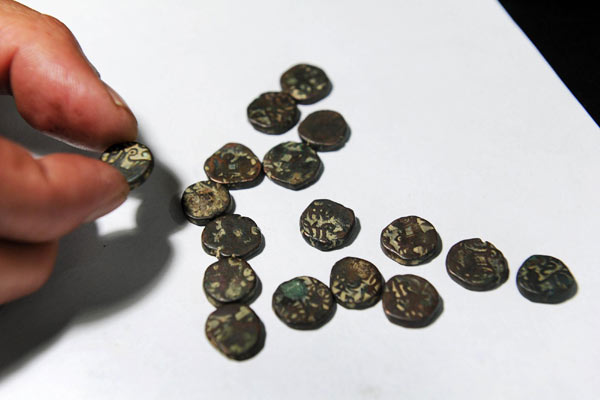 |
|
More than a dozen copper coins are unearthed in Xiji county, Ningxia Hui autonomous region, once the northeast part of Silk Road, Oct 10, 2012. The coins were made of bronze, with animal images and hieroglyphic symbols on each side. Each one weighs about 2.4-3.7 grams and is 1.2-1.5 centimeters in diameter, and 0.25 centimeters in thickness. They were found to be handed down from the the Kushan Empire (AD30-375), an ancient central Asia dynasty and later based near Kabul, Afghanistan. The Kushan coin had great historic value along the ancient Silk Road and was generally made in the Greek style and of gold, silver and bronze materials. [Photo/Xinhua]
|
Rise and Decline
The Silk Road approached its heyday in the Han Dynasty (206 BC-AD 220), although travel along it began much earlier. Archeologists confirm the existence of an intermittent trade route across the prairies along the Nile, Tigris, Euphrates, Indus and Yellow rivers, consisting of a number of minor passages that caravans traversed.
As early as 5,000 years ago, lapis lazuli, the deep blue semi-precious stone originating in Afghanistan, had made its way into Egypt. This further attests to the flow of goods along this prairie passage that later evolved into the Silk Road. About 1,000 years later, lapis lazuli was brought into Harappa, a large city of the Indus Civilization. Soon after it entered China, and became revered as one of the seven treasures of Buddhism.
Soft jade artifacts from Xinjiang found in the tomb of Lady Hao, concubine of King Wuding (?-1192 BC), last monarch of the Shang Dynasty (C. 2100-1600 BC), constitute more evidence of exchanges between the inland Chinese civilization and neighboring regimes to its west and beyond.
Dr. Guo Wu of the Institute of Archaeology, Chinese Academy of Social Sciences, has made a study of bronze fu, the vessel that nomads traditionally used for cooking and sacrificial rituals, unearthed over the past decade in China, Russia and Mongolia. He concludes that this artifact first appeared in northern China and later spread to prairie communities in the north and west before reaching Eurasian countries.
Zhang Qian (?-114 BC), of the Western Han Dynasty, the first Chinese envoy to Central Asia, noticed in a market in Daxia – the Chinese name for today’s Afghanistan – bamboo walking sticks and fabrics made in Sichuan province. This observation, again, implies early trade ties between China and Central Asia.
Exchanges between China and the world peaked during the Han Dynasty. In 138 BC a delegation of more than 100 people led by Zhang Qian left the Han capital of Chang’an (today’s Xi’an) for countries to the empire’s west, historically known as the Western Regions. To show their good will, the many regimes Zhang visited sent reciprocal delegates to Western Han. During the subsequent Eastern Han Dynasty, Ban Chao (AD 32-102) made several trips to the Western Regions and was later appointed official in charge of affairs there. In AD 97 Ban dispatched Gan Ying to Rome, but stormy weather on the seas forced him to drop anchor in the Persian Gulf. As a consequence, little more than half a century later in AD 166 a Persian delegation arrived in Luoyang, capital of the Eastern Han. This was the first direct contact between China and Europe.
Traffic along the Silk Road gained pace during the Tang Dynasty (618-907). Records show that about 4,000 Arab and Persian expatriates purchased properties in China at that time. When Huang Chao and his rebels sacked Guangzhou towards the end of the dynasty in 879, the local population of Jews, Roman immigrants, Christians and Zoroastrians numbered between 120,000 and 200,000.
In the dynasties after the Tang, China’s economic center gradually gravitated south, closer to the coast. This led to the southward extension of the terrestrial Silk Road and establishment of the maritime Silk Road. Southern cities like Guangzhou, Chengdu and Quanzhou consequently became economic hubs.
The Mongol invasions in the 13th century under Genghis Khan (1162-1227) of North and West Asia promoted connectivity between China and Europe. On receiving passes from the Mongol empire, merchants and emissaries were free to travel between the two destinations.
We Recommend:
